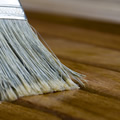Sanding and Waterlox®.
Sanding for adhesion purposes is not required between coats of Waterlox®s Tung oil based, penetrating finishes, making them unique. Most surface finishes such as urethanes require the sanding process to create what’s called a “profile”. A profile is similar to a mountain range microscopically. Failure to sand/abrade between coats of a surface finish can result … Sanding and Waterlox®.







